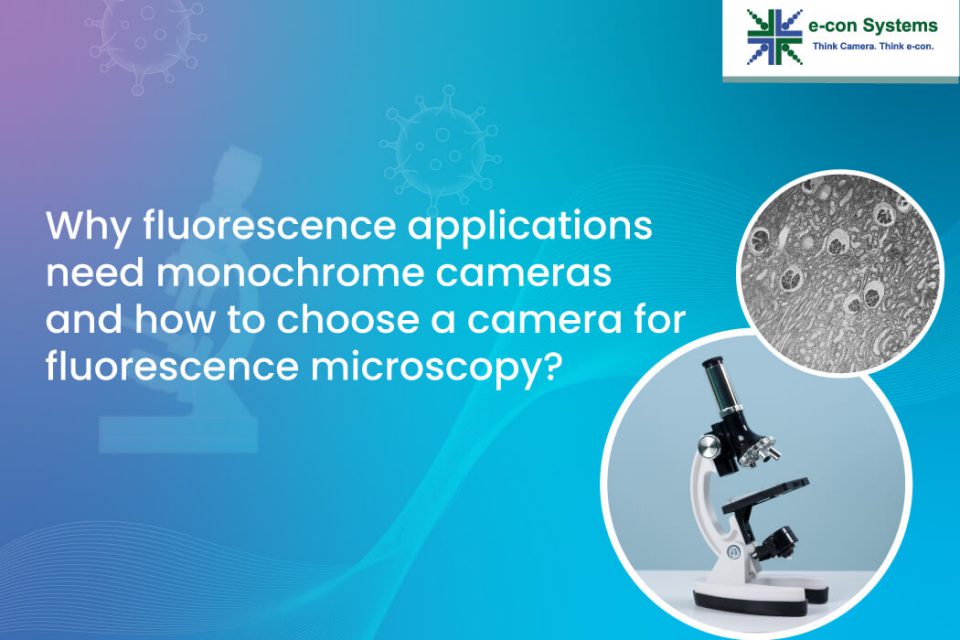Selecting the right camera for fluorescence microscopy or other medical and life science applications can be challenging. After all, there are many factors to consider. Features like sensitivity, noise, resolution, etc., tend to play a significant role in the decision-making process. However, it’s also important to consider your specific requirements, as different types of samples and imaging modalities may require different camera specifications. It’s why you need an all-in-one fluorescence camera that will take care of all your needs.
In this article, you’ll know fluorescence applications see monochrome cameras as the best option – and find out the main factors to evaluate while selecting the right fluorescence microscope camera. Also, get to know the latest release by e-con Systems – and how it can boost the imaging performance of your embedded vision application.
Why monochrome cameras are preferred for fluorescence applications
Simply put, monochrome cameras are preferred for fluorescence applications because they offer higher sensitivity and dynamic range compared to color cameras.
In fluorescence applications, a sample is illuminated with light of a specific wavelength, which causes it to emit light of a longer wavelength. This emitted light is then captured by a camera and recorded as an image. Now, this light is typically very weak, so the camera must be sensitive enough to detect even small amounts of light.
Monochrome cameras are typically more sensitive to light than color cameras because they use a single sensor to capture all of the light rather than splitting the light into separate red, green, and blue channels like a color camera. This means that monochrome cameras can capture more of the light emitted by the sample, resulting in higher sensitivity and better image quality.
In addition, monochrome cameras have a wider dynamic range than color cameras, meaning they can capture a wider range of light intensities without losing detail. This is important for fluorescence applications, where the sample may emit light at different intensities across the image.
Overall, the higher sensitivity and dynamic range of monochrome cameras make them well-suited for fluorescence applications, where capturing weak signals is critical for accurate imaging.
Fluorescence microscopy uses fluorescence to visualize biological samples. So, picking the right camera can be a complex process. See why monochrome cameras are the best option, know all the critical factors to consider, and understand why monochrome cameras are generally preferred over color cameras. https://www.e-consystems.com/blog/camera/technology/a-short-guide-to-why-monochrome-cameras-have-the-edge-over-color-cameras/
What is fluorescence microscopy?
Fluorescence microscopy is a type of microscopy that uses fluorescence to visualize biological samples. It involves adding a fluorescent molecule (fluorophore) to the sample – thereby absorbing light of a specific wavelength and emitting light of a longer wavelength. The emitted light can be visualized and captured by a digital microscope.
Fluorescence microscopy is widely used in many fields of biology, including cell biology, neuroscience, developmental biology, and microbiology, as well as in medical research and diagnostics. There are also several types of fluorescence microscopy, such as wide-field fluorescence microscopy, confocal microscopy, two-photon microscopy, and super-resolution microscopy.
5 deciding factors while selecting a fluorescence microscope camera
Choosing a fluorescence camera for microscopy involves considering several important factors, including sensitivity, noise level, resolution, speed, and compatibility with the microscope system. Here are some key factors to consider:
-
High Sensitivity
The fluorescence microscope camera’s sensitivity determines its ability to capture faint fluorescence signals. So, it would help if you had a camera with high Quantum Efficiency (QE), which is a measure of the percentage of photons that are converted into electrical signals. A higher QE means more efficient detection of the fluorescence signal.
-
Noise Levels
The fluorescence camera’s low noise is crucial for fluorescence imaging. It ensures that the signal is not obscured by random background noise.
-
High Resolution
The fluorescence microscope camera’s resolution determines the level of detail that can be captured in the image. Hence, it is important to choose a camera with a resolution that is appropriate for the magnification of your microscope.
-
Imaging Speed
Fluorescence microscope cameras often require capturing dynamic events or rapid changes in the sample. So, your camera must be equipped with a high frame rate or fast readout speed to capture these events.
-
System Compatibility
Of course, it is critical to ensure that the fluorescence camera is compatible with your microscope system – including the interface and software.
See3CAM_50CUGM – a brand-new camera by e-con Systems for fluorescence applications
Based on the Sony Pregius IMX264 CMOS sensor, See3CAM_50CUGM is a 5MP high-sensitivity fixed focus camera – perfect for fluorescence applications, including digital microscopes. It comes with back-illuminated pixel technology and a large pixel size of 3.45µm to give your embedded vision device both high sensitivity and high Quantum Efficiency (QE). In fact, you will get approximately 20% superior efficiency when compared to the Sony STARVIS series! Its global shutter readout feature also ensures distortion-free capture of fast-moving targets. Some of its other features include large pixel size, high dynamic range, high frame rate images, and IR sensitivity for Near Infrared (NIR) performance.
Camera solution for Medical Microscope to Improve the Accuracy & Speed of Diagnosis
Of course, if you need help integrating camera solutions into your vision-based medical or life science application, we are just an email away. Please write to us at camerasolutions@e-consystems.com. You can also check out our Camera Selector page to see our entire portfolio of cameras.

Balaji is a camera expert with 18+ years of experience in embedded product design, camera solutions, and product development. In e-con Systems, he has built numerous camera solutions in the field of ophthalmology, laboratory equipment, dentistry, assistive technology, dermatology, and more. He has played an integral part in helping many customers build their products by integrating the right vision technology into them.


